Ministerial Briefing Note: Indigenous Life Expectancy Report
VerifiedAdded on 2021/06/14
|6
|1631
|55
Report
AI Summary
This Ministerial Briefing Note addresses the critical issue of increasing Indigenous life expectancy in Australia. It begins by outlining the background of the 'Closing the Gap' initiative, highlighting the significant disparity in life expectancy between Indigenous and non-Indigenous Australians. The note identifies key issues such as higher mortality rates, chronic diseases, and behavioral risk factors, including smoking, alcohol consumption, and diet. It then proposes several policy options, including promoting anti-smoking initiatives, enforcing regulations on tobacco and alcohol sales, improving oral health and nutrition, enhancing primary health care services, and implementing effective women's healthcare services. The report recommends partnerships between Indigenous communities and health services, improved cultural effectiveness of healthcare providers, and strengthened pathways between acute and primary care. It also suggests providing cultural support in hospitals and promoting evidence-based interventions to achieve sustainable improvements in Indigenous health outcomes. The note emphasizes the urgency of addressing these issues to close the life expectancy gap and improve the overall health and well-being of Indigenous Australians.
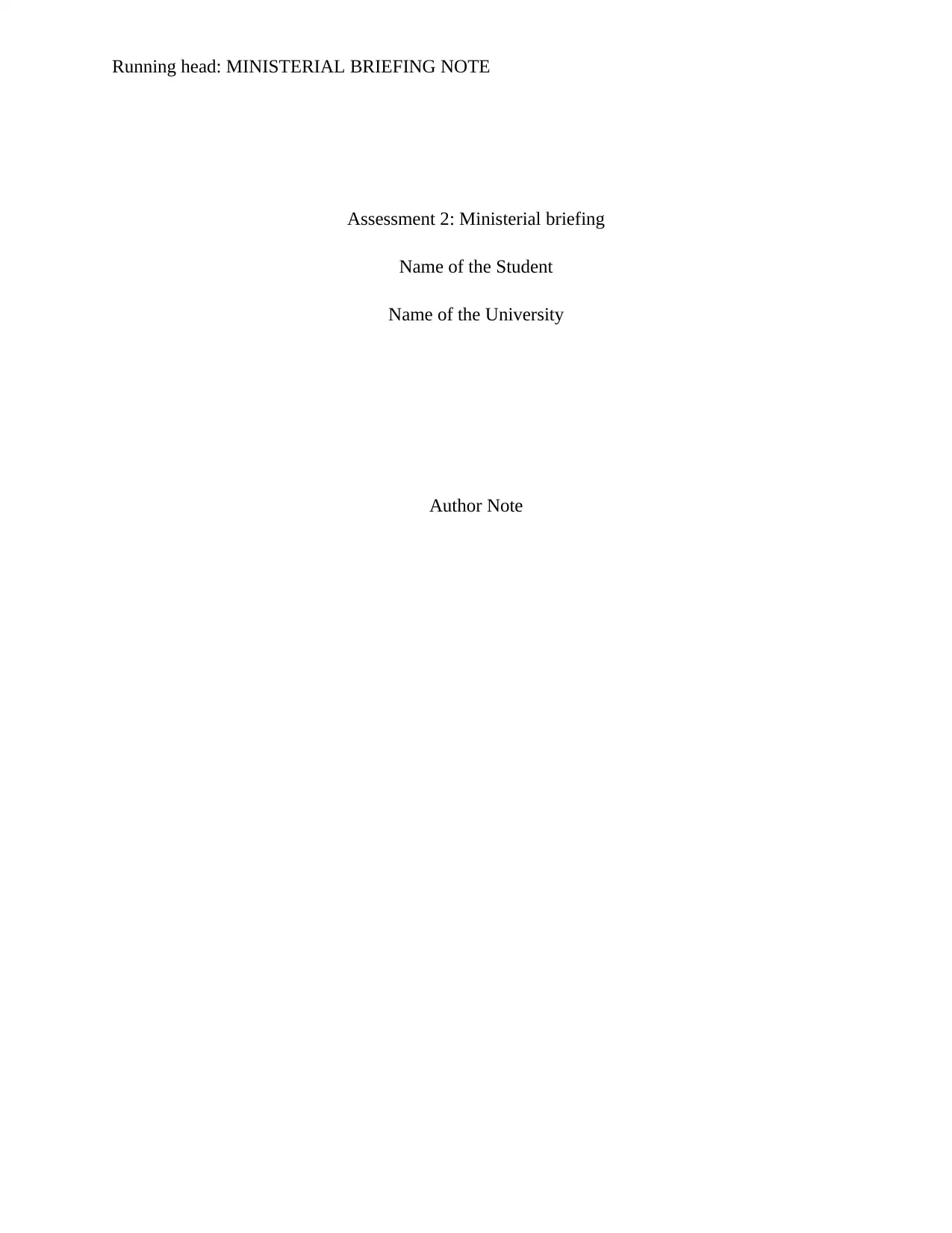
Running head: MINISTERIAL BRIEFING NOTE
Assessment 2: Ministerial briefing
Name of the Student
Name of the University
Author Note
Assessment 2: Ministerial briefing
Name of the Student
Name of the University
Author Note
Paraphrase This Document
Need a fresh take? Get an instant paraphrase of this document with our AI Paraphraser
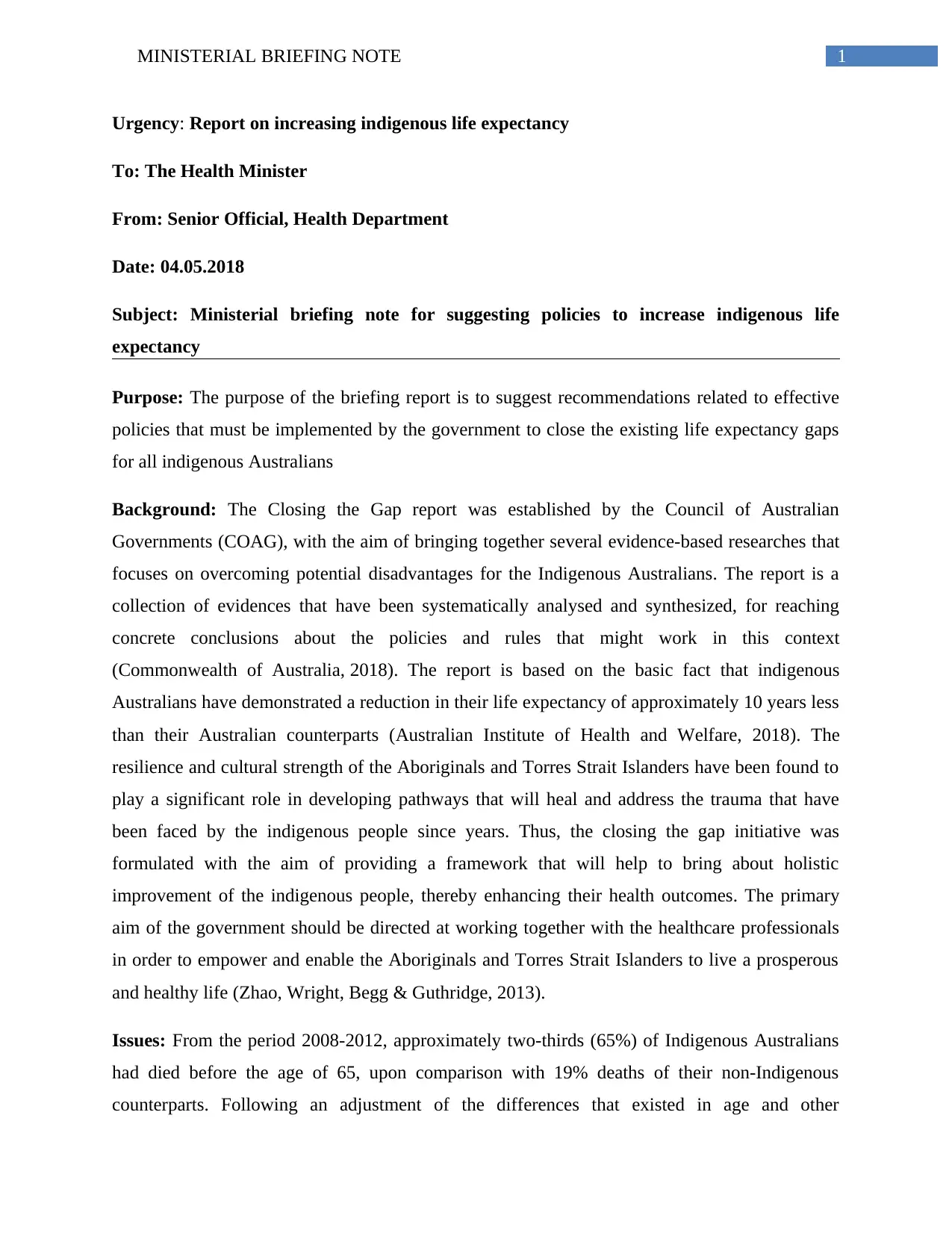
1MINISTERIAL BRIEFING NOTE
Urgency: Report on increasing indigenous life expectancy
To: The Health Minister
From: Senior Official, Health Department
Date: 04.05.2018
Subject: Ministerial briefing note for suggesting policies to increase indigenous life
expectancy
Purpose: The purpose of the briefing report is to suggest recommendations related to effective
policies that must be implemented by the government to close the existing life expectancy gaps
for all indigenous Australians
Background: The Closing the Gap report was established by the Council of Australian
Governments (COAG), with the aim of bringing together several evidence-based researches that
focuses on overcoming potential disadvantages for the Indigenous Australians. The report is a
collection of evidences that have been systematically analysed and synthesized, for reaching
concrete conclusions about the policies and rules that might work in this context
(Commonwealth of Australia, 2018). The report is based on the basic fact that indigenous
Australians have demonstrated a reduction in their life expectancy of approximately 10 years less
than their Australian counterparts (Australian Institute of Health and Welfare, 2018). The
resilience and cultural strength of the Aboriginals and Torres Strait Islanders have been found to
play a significant role in developing pathways that will heal and address the trauma that have
been faced by the indigenous people since years. Thus, the closing the gap initiative was
formulated with the aim of providing a framework that will help to bring about holistic
improvement of the indigenous people, thereby enhancing their health outcomes. The primary
aim of the government should be directed at working together with the healthcare professionals
in order to empower and enable the Aboriginals and Torres Strait Islanders to live a prosperous
and healthy life (Zhao, Wright, Begg & Guthridge, 2013).
Issues: From the period 2008-2012, approximately two-thirds (65%) of Indigenous Australians
had died before the age of 65, upon comparison with 19% deaths of their non-Indigenous
counterparts. Following an adjustment of the differences that existed in age and other
Urgency: Report on increasing indigenous life expectancy
To: The Health Minister
From: Senior Official, Health Department
Date: 04.05.2018
Subject: Ministerial briefing note for suggesting policies to increase indigenous life
expectancy
Purpose: The purpose of the briefing report is to suggest recommendations related to effective
policies that must be implemented by the government to close the existing life expectancy gaps
for all indigenous Australians
Background: The Closing the Gap report was established by the Council of Australian
Governments (COAG), with the aim of bringing together several evidence-based researches that
focuses on overcoming potential disadvantages for the Indigenous Australians. The report is a
collection of evidences that have been systematically analysed and synthesized, for reaching
concrete conclusions about the policies and rules that might work in this context
(Commonwealth of Australia, 2018). The report is based on the basic fact that indigenous
Australians have demonstrated a reduction in their life expectancy of approximately 10 years less
than their Australian counterparts (Australian Institute of Health and Welfare, 2018). The
resilience and cultural strength of the Aboriginals and Torres Strait Islanders have been found to
play a significant role in developing pathways that will heal and address the trauma that have
been faced by the indigenous people since years. Thus, the closing the gap initiative was
formulated with the aim of providing a framework that will help to bring about holistic
improvement of the indigenous people, thereby enhancing their health outcomes. The primary
aim of the government should be directed at working together with the healthcare professionals
in order to empower and enable the Aboriginals and Torres Strait Islanders to live a prosperous
and healthy life (Zhao, Wright, Begg & Guthridge, 2013).
Issues: From the period 2008-2012, approximately two-thirds (65%) of Indigenous Australians
had died before the age of 65, upon comparison with 19% deaths of their non-Indigenous
counterparts. Following an adjustment of the differences that existed in age and other
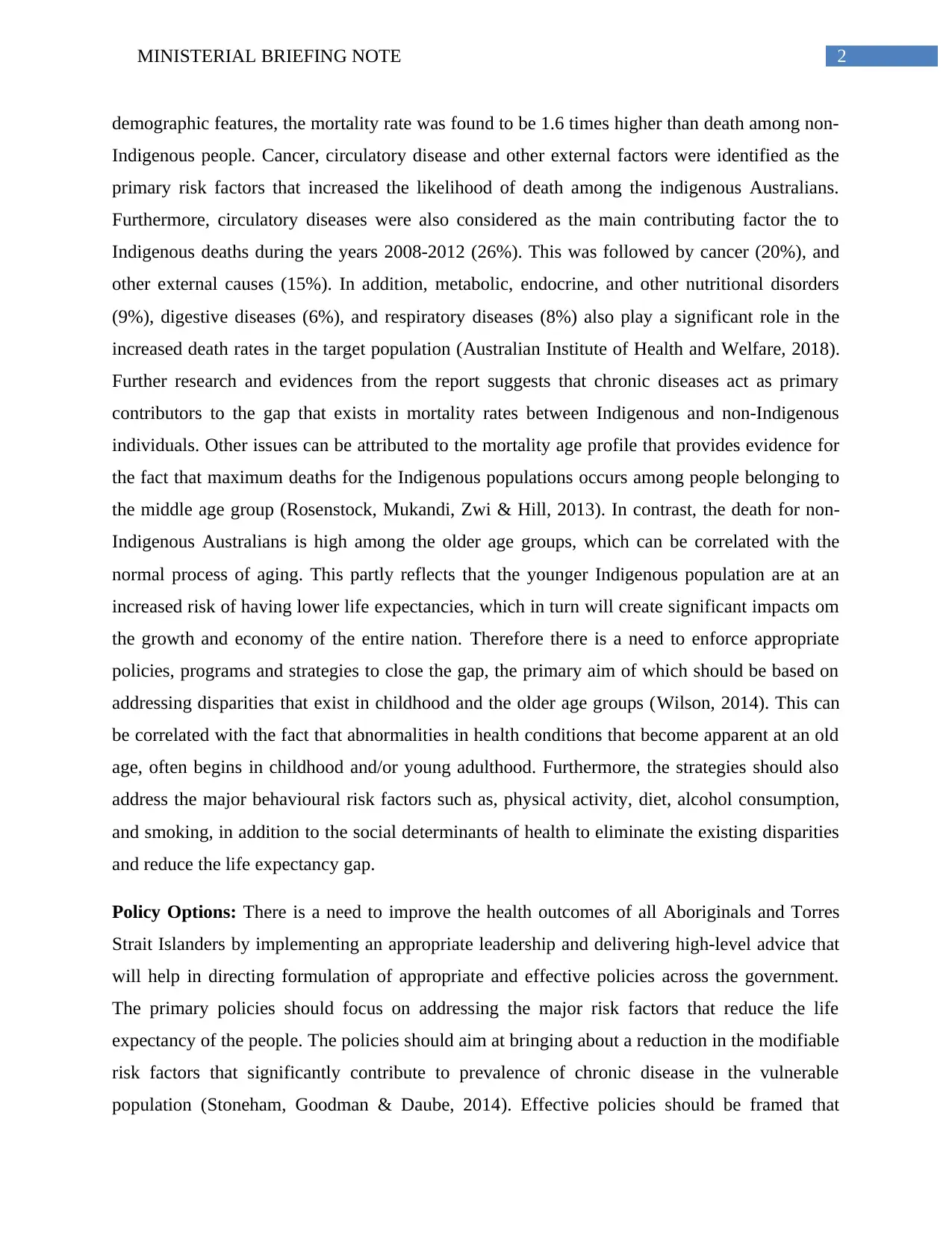
2MINISTERIAL BRIEFING NOTE
demographic features, the mortality rate was found to be 1.6 times higher than death among non-
Indigenous people. Cancer, circulatory disease and other external factors were identified as the
primary risk factors that increased the likelihood of death among the indigenous Australians.
Furthermore, circulatory diseases were also considered as the main contributing factor the to
Indigenous deaths during the years 2008-2012 (26%). This was followed by cancer (20%), and
other external causes (15%). In addition, metabolic, endocrine, and other nutritional disorders
(9%), digestive diseases (6%), and respiratory diseases (8%) also play a significant role in the
increased death rates in the target population (Australian Institute of Health and Welfare, 2018).
Further research and evidences from the report suggests that chronic diseases act as primary
contributors to the gap that exists in mortality rates between Indigenous and non-Indigenous
individuals. Other issues can be attributed to the mortality age profile that provides evidence for
the fact that maximum deaths for the Indigenous populations occurs among people belonging to
the middle age group (Rosenstock, Mukandi, Zwi & Hill, 2013). In contrast, the death for non-
Indigenous Australians is high among the older age groups, which can be correlated with the
normal process of aging. This partly reflects that the younger Indigenous population are at an
increased risk of having lower life expectancies, which in turn will create significant impacts om
the growth and economy of the entire nation. Therefore there is a need to enforce appropriate
policies, programs and strategies to close the gap, the primary aim of which should be based on
addressing disparities that exist in childhood and the older age groups (Wilson, 2014). This can
be correlated with the fact that abnormalities in health conditions that become apparent at an old
age, often begins in childhood and/or young adulthood. Furthermore, the strategies should also
address the major behavioural risk factors such as, physical activity, diet, alcohol consumption,
and smoking, in addition to the social determinants of health to eliminate the existing disparities
and reduce the life expectancy gap.
Policy Options: There is a need to improve the health outcomes of all Aboriginals and Torres
Strait Islanders by implementing an appropriate leadership and delivering high-level advice that
will help in directing formulation of appropriate and effective policies across the government.
The primary policies should focus on addressing the major risk factors that reduce the life
expectancy of the people. The policies should aim at bringing about a reduction in the modifiable
risk factors that significantly contribute to prevalence of chronic disease in the vulnerable
population (Stoneham, Goodman & Daube, 2014). Effective policies should be framed that
demographic features, the mortality rate was found to be 1.6 times higher than death among non-
Indigenous people. Cancer, circulatory disease and other external factors were identified as the
primary risk factors that increased the likelihood of death among the indigenous Australians.
Furthermore, circulatory diseases were also considered as the main contributing factor the to
Indigenous deaths during the years 2008-2012 (26%). This was followed by cancer (20%), and
other external causes (15%). In addition, metabolic, endocrine, and other nutritional disorders
(9%), digestive diseases (6%), and respiratory diseases (8%) also play a significant role in the
increased death rates in the target population (Australian Institute of Health and Welfare, 2018).
Further research and evidences from the report suggests that chronic diseases act as primary
contributors to the gap that exists in mortality rates between Indigenous and non-Indigenous
individuals. Other issues can be attributed to the mortality age profile that provides evidence for
the fact that maximum deaths for the Indigenous populations occurs among people belonging to
the middle age group (Rosenstock, Mukandi, Zwi & Hill, 2013). In contrast, the death for non-
Indigenous Australians is high among the older age groups, which can be correlated with the
normal process of aging. This partly reflects that the younger Indigenous population are at an
increased risk of having lower life expectancies, which in turn will create significant impacts om
the growth and economy of the entire nation. Therefore there is a need to enforce appropriate
policies, programs and strategies to close the gap, the primary aim of which should be based on
addressing disparities that exist in childhood and the older age groups (Wilson, 2014). This can
be correlated with the fact that abnormalities in health conditions that become apparent at an old
age, often begins in childhood and/or young adulthood. Furthermore, the strategies should also
address the major behavioural risk factors such as, physical activity, diet, alcohol consumption,
and smoking, in addition to the social determinants of health to eliminate the existing disparities
and reduce the life expectancy gap.
Policy Options: There is a need to improve the health outcomes of all Aboriginals and Torres
Strait Islanders by implementing an appropriate leadership and delivering high-level advice that
will help in directing formulation of appropriate and effective policies across the government.
The primary policies should focus on addressing the major risk factors that reduce the life
expectancy of the people. The policies should aim at bringing about a reduction in the modifiable
risk factors that significantly contribute to prevalence of chronic disease in the vulnerable
population (Stoneham, Goodman & Daube, 2014). Effective policies should be framed that
⊘ This is a preview!⊘
Do you want full access?
Subscribe today to unlock all pages.

Trusted by 1+ million students worldwide
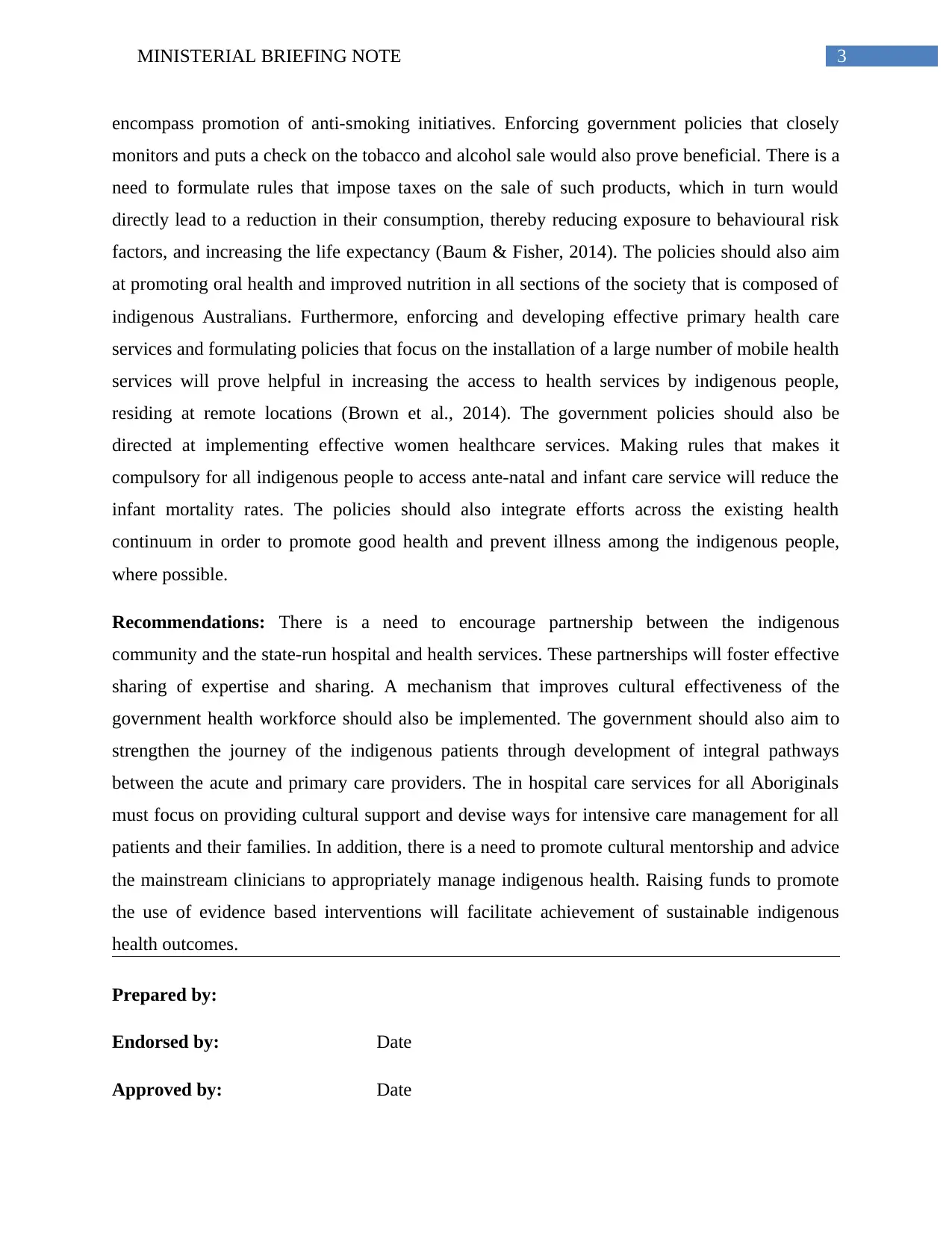
3MINISTERIAL BRIEFING NOTE
encompass promotion of anti-smoking initiatives. Enforcing government policies that closely
monitors and puts a check on the tobacco and alcohol sale would also prove beneficial. There is a
need to formulate rules that impose taxes on the sale of such products, which in turn would
directly lead to a reduction in their consumption, thereby reducing exposure to behavioural risk
factors, and increasing the life expectancy (Baum & Fisher, 2014). The policies should also aim
at promoting oral health and improved nutrition in all sections of the society that is composed of
indigenous Australians. Furthermore, enforcing and developing effective primary health care
services and formulating policies that focus on the installation of a large number of mobile health
services will prove helpful in increasing the access to health services by indigenous people,
residing at remote locations (Brown et al., 2014). The government policies should also be
directed at implementing effective women healthcare services. Making rules that makes it
compulsory for all indigenous people to access ante-natal and infant care service will reduce the
infant mortality rates. The policies should also integrate efforts across the existing health
continuum in order to promote good health and prevent illness among the indigenous people,
where possible.
Recommendations: There is a need to encourage partnership between the indigenous
community and the state-run hospital and health services. These partnerships will foster effective
sharing of expertise and sharing. A mechanism that improves cultural effectiveness of the
government health workforce should also be implemented. The government should also aim to
strengthen the journey of the indigenous patients through development of integral pathways
between the acute and primary care providers. The in hospital care services for all Aboriginals
must focus on providing cultural support and devise ways for intensive care management for all
patients and their families. In addition, there is a need to promote cultural mentorship and advice
the mainstream clinicians to appropriately manage indigenous health. Raising funds to promote
the use of evidence based interventions will facilitate achievement of sustainable indigenous
health outcomes.
Prepared by:
Endorsed by: Date
Approved by: Date
encompass promotion of anti-smoking initiatives. Enforcing government policies that closely
monitors and puts a check on the tobacco and alcohol sale would also prove beneficial. There is a
need to formulate rules that impose taxes on the sale of such products, which in turn would
directly lead to a reduction in their consumption, thereby reducing exposure to behavioural risk
factors, and increasing the life expectancy (Baum & Fisher, 2014). The policies should also aim
at promoting oral health and improved nutrition in all sections of the society that is composed of
indigenous Australians. Furthermore, enforcing and developing effective primary health care
services and formulating policies that focus on the installation of a large number of mobile health
services will prove helpful in increasing the access to health services by indigenous people,
residing at remote locations (Brown et al., 2014). The government policies should also be
directed at implementing effective women healthcare services. Making rules that makes it
compulsory for all indigenous people to access ante-natal and infant care service will reduce the
infant mortality rates. The policies should also integrate efforts across the existing health
continuum in order to promote good health and prevent illness among the indigenous people,
where possible.
Recommendations: There is a need to encourage partnership between the indigenous
community and the state-run hospital and health services. These partnerships will foster effective
sharing of expertise and sharing. A mechanism that improves cultural effectiveness of the
government health workforce should also be implemented. The government should also aim to
strengthen the journey of the indigenous patients through development of integral pathways
between the acute and primary care providers. The in hospital care services for all Aboriginals
must focus on providing cultural support and devise ways for intensive care management for all
patients and their families. In addition, there is a need to promote cultural mentorship and advice
the mainstream clinicians to appropriately manage indigenous health. Raising funds to promote
the use of evidence based interventions will facilitate achievement of sustainable indigenous
health outcomes.
Prepared by:
Endorsed by: Date
Approved by: Date
Paraphrase This Document
Need a fresh take? Get an instant paraphrase of this document with our AI Paraphraser
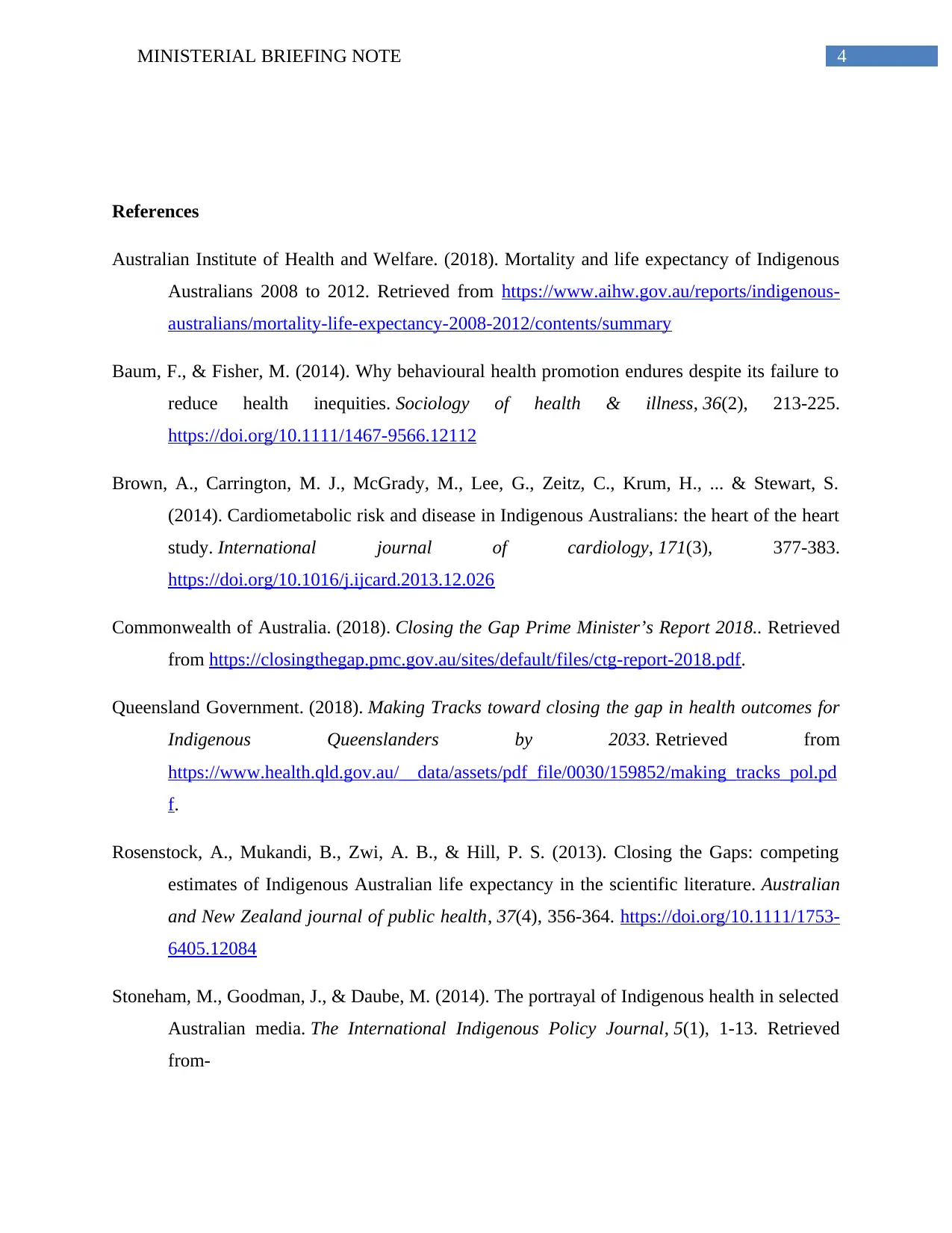
4MINISTERIAL BRIEFING NOTE
References
Australian Institute of Health and Welfare. (2018). Mortality and life expectancy of Indigenous
Australians 2008 to 2012. Retrieved from https://www.aihw.gov.au/reports/indigenous-
australians/mortality-life-expectancy-2008-2012/contents/summary
Baum, F., & Fisher, M. (2014). Why behavioural health promotion endures despite its failure to
reduce health inequities. Sociology of health & illness, 36(2), 213-225.
https://doi.org/10.1111/1467-9566.12112
Brown, A., Carrington, M. J., McGrady, M., Lee, G., Zeitz, C., Krum, H., ... & Stewart, S.
(2014). Cardiometabolic risk and disease in Indigenous Australians: the heart of the heart
study. International journal of cardiology, 171(3), 377-383.
https://doi.org/10.1016/j.ijcard.2013.12.026
Commonwealth of Australia. (2018). Closing the Gap Prime Minister’s Report 2018.. Retrieved
from https://closingthegap.pmc.gov.au/sites/default/files/ctg-report-2018.pdf.
Queensland Government. (2018). Making Tracks toward closing the gap in health outcomes for
Indigenous Queenslanders by 2033. Retrieved from
https://www.health.qld.gov.au/__data/assets/pdf_file/0030/159852/making_tracks_pol.pd
f.
Rosenstock, A., Mukandi, B., Zwi, A. B., & Hill, P. S. (2013). Closing the Gaps: competing
estimates of Indigenous Australian life expectancy in the scientific literature. Australian
and New Zealand journal of public health, 37(4), 356-364. https://doi.org/10.1111/1753-
6405.12084
Stoneham, M., Goodman, J., & Daube, M. (2014). The portrayal of Indigenous health in selected
Australian media. The International Indigenous Policy Journal, 5(1), 1-13. Retrieved
from-
References
Australian Institute of Health and Welfare. (2018). Mortality and life expectancy of Indigenous
Australians 2008 to 2012. Retrieved from https://www.aihw.gov.au/reports/indigenous-
australians/mortality-life-expectancy-2008-2012/contents/summary
Baum, F., & Fisher, M. (2014). Why behavioural health promotion endures despite its failure to
reduce health inequities. Sociology of health & illness, 36(2), 213-225.
https://doi.org/10.1111/1467-9566.12112
Brown, A., Carrington, M. J., McGrady, M., Lee, G., Zeitz, C., Krum, H., ... & Stewart, S.
(2014). Cardiometabolic risk and disease in Indigenous Australians: the heart of the heart
study. International journal of cardiology, 171(3), 377-383.
https://doi.org/10.1016/j.ijcard.2013.12.026
Commonwealth of Australia. (2018). Closing the Gap Prime Minister’s Report 2018.. Retrieved
from https://closingthegap.pmc.gov.au/sites/default/files/ctg-report-2018.pdf.
Queensland Government. (2018). Making Tracks toward closing the gap in health outcomes for
Indigenous Queenslanders by 2033. Retrieved from
https://www.health.qld.gov.au/__data/assets/pdf_file/0030/159852/making_tracks_pol.pd
f.
Rosenstock, A., Mukandi, B., Zwi, A. B., & Hill, P. S. (2013). Closing the Gaps: competing
estimates of Indigenous Australian life expectancy in the scientific literature. Australian
and New Zealand journal of public health, 37(4), 356-364. https://doi.org/10.1111/1753-
6405.12084
Stoneham, M., Goodman, J., & Daube, M. (2014). The portrayal of Indigenous health in selected
Australian media. The International Indigenous Policy Journal, 5(1), 1-13. Retrieved
from-
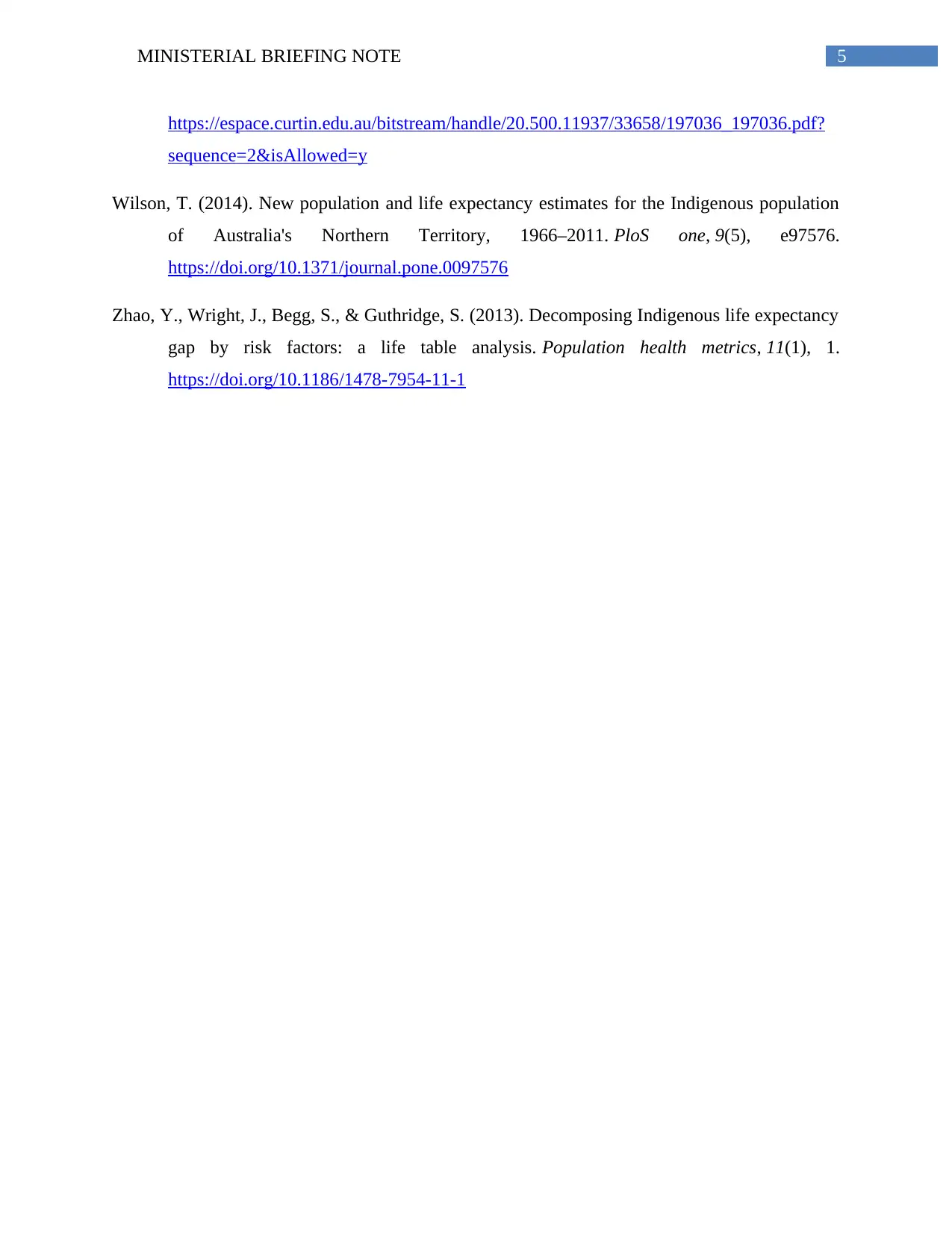
5MINISTERIAL BRIEFING NOTE
https://espace.curtin.edu.au/bitstream/handle/20.500.11937/33658/197036_197036.pdf?
sequence=2&isAllowed=y
Wilson, T. (2014). New population and life expectancy estimates for the Indigenous population
of Australia's Northern Territory, 1966–2011. PloS one, 9(5), e97576.
https://doi.org/10.1371/journal.pone.0097576
Zhao, Y., Wright, J., Begg, S., & Guthridge, S. (2013). Decomposing Indigenous life expectancy
gap by risk factors: a life table analysis. Population health metrics, 11(1), 1.
https://doi.org/10.1186/1478-7954-11-1
https://espace.curtin.edu.au/bitstream/handle/20.500.11937/33658/197036_197036.pdf?
sequence=2&isAllowed=y
Wilson, T. (2014). New population and life expectancy estimates for the Indigenous population
of Australia's Northern Territory, 1966–2011. PloS one, 9(5), e97576.
https://doi.org/10.1371/journal.pone.0097576
Zhao, Y., Wright, J., Begg, S., & Guthridge, S. (2013). Decomposing Indigenous life expectancy
gap by risk factors: a life table analysis. Population health metrics, 11(1), 1.
https://doi.org/10.1186/1478-7954-11-1
⊘ This is a preview!⊘
Do you want full access?
Subscribe today to unlock all pages.

Trusted by 1+ million students worldwide
1 out of 6
Related Documents
Your All-in-One AI-Powered Toolkit for Academic Success.
+13062052269
info@desklib.com
Available 24*7 on WhatsApp / Email
![[object Object]](/_next/static/media/star-bottom.7253800d.svg)
Unlock your academic potential
Copyright © 2020–2025 A2Z Services. All Rights Reserved. Developed and managed by ZUCOL.





